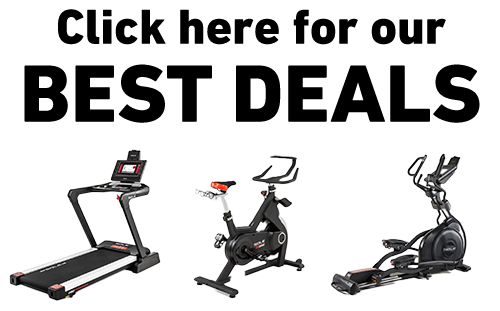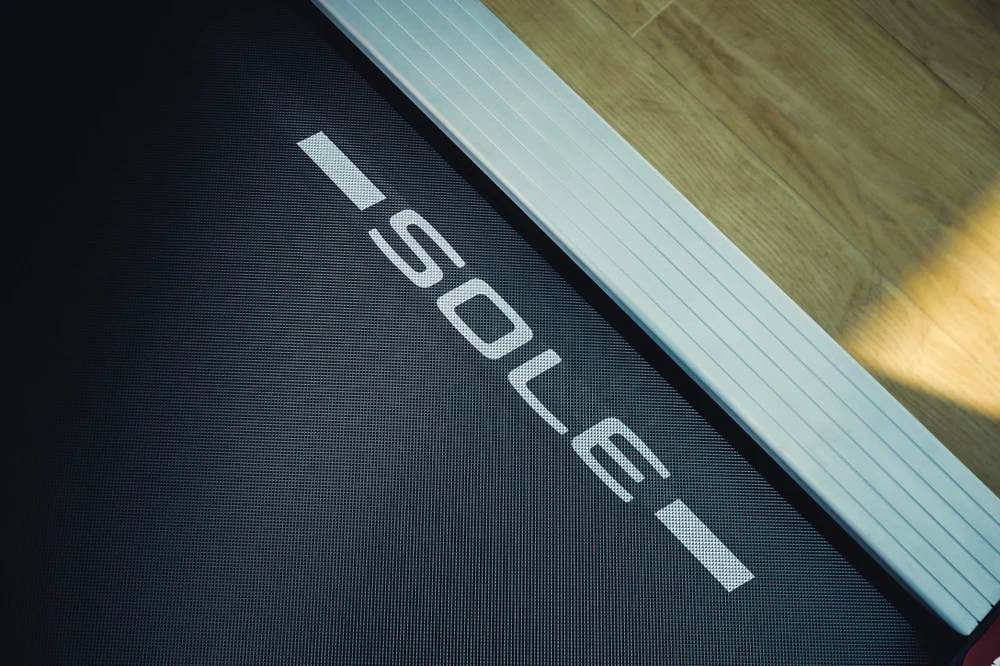Key Takeaways
- HIIT stands for High-Intensity Interval Training, a workout method involving short bursts of intense activity followed by periods of rest or low-intensity exercise.
- HIIT workouts on a treadmill can improve cardiovascular health, burn calories efficiently, and build muscle.
- Beginner, intermediate, and advanced HIIT treadmill routines vary in intensity and duration, allowing for progressive improvement.
- SOLE treadmills offer features like adjustable speeds and inclines, making them ideal for HIIT workouts.
- Always start with a warm-up and end with a cool-down to prevent injuries and maximize benefits.
|
At SOLE Fitness, we're proud to offer the best treadmills for your home or gym. These machines are crafted to meet the highest standards of quality and performance, ensuring they are ideal for anyone - from fitness novices to seasoned athletes. Featured Product
|
What is HIIT?
HIIT, or High-Intensity Interval Training, is a workout method that alternates between short bursts of intense exercise and periods of rest or low-intensity activity. The goal is to push your body to its maximum capacity during the high-intensity intervals and then allow it to recover during the low-intensity periods. This type of training is efficient and effective in improving cardiovascular health, burning calories, and building muscle.
Benefits of HIIT
HIIT workouts offer numerous benefits - here are some of them:
- Improved Cardiovascular Health: HIIT workouts increase your heart rate, improving cardiovascular endurance.
- Calorie Burning: The high-intensity intervals increase your metabolism, leading to significant calorie burn even after the workout.
- Muscle Building: HIIT workouts engage multiple muscle groups, promoting muscle growth and strength.
- Time Efficiency: HIIT workouts are typically shorter than traditional workouts, making them ideal for busy schedules.
- Versatility: HIIT can be adapted to various fitness levels and equipment, including treadmills.
Preparation for HIIT
Essential Gear
Before starting a HIIT treadmill workout, ensure you have the right gear: comfortable athletic wear, supportive running shoes, and a water bottle are must-haves. Additionally, consider using a fitness tracker to monitor your heart rate and progress. Fortunately, with SOLE treadmills, you’ll get water bottle holders and heart rate trackers built into the equipment.

Choosing the Right Treadmill
A quality treadmill is crucial for a successful HIIT workout. SOLE treadmills, such as the F63 and F85, have features like adjustable speeds, inclines, and built-in HIIT programs. These features make it easier to switch between high-intensity and low-intensity intervals without manually adjusting the settings.
Here’s a sample of pre-programmed workout routines that come with the SOLE treadmills.

Warm-Up
Dynamic Stretches
Warming up is essential to prepare your body for the intense workout ahead and to prevent injuries. Start with dynamic stretches such as leg swings, arm circles, and torso twists - these movements help increase blood flow to your muscles and improve your range of motion.

Light Jog or Walk
After dynamic stretches, transition into a light jog or walk on the treadmill for about 5 minutes. This will gradually increase your heart rate and further loosen up your muscles, setting the stage for the high-intensity intervals to come.
HIIT Workout Structure
High-Intensity Intervals
The high-intensity intervals are the core of your HIIT workout: during these periods, you should push yourself to your maximum effort. For example, you might sprint at a speed of 8-9 mph for 30 seconds to 1 minute. The goal is to challenge your cardiovascular system and muscles to their limits.
Recovery Intervals
After each high-intensity interval, follow up with a recovery interval. This is a period of low-intensity exercise, such as walking or slow jogging, allowing your heart rate to decrease and your muscles to recover. Typically, recovery intervals last 1-2 minutes, but you can adjust the duration based on your fitness level.
For beginners, a 1:2 ratio (high-intensity to recovery) is a good starting point. Intermediate users might try a 1:1 ratio, while advanced users can push for a 2:1 ratio.
Timing and Duration
A standard HIIT treadmill workout lasts about 20-30 minutes, including warm-up and cool-down. The high-intensity intervals usually last between 30 seconds to 1 minute, while the recovery intervals can range from 1 to 2 minutes.
Here's a breakdown of timing and duration for different fitness levels:
- Beginners: 30 seconds sprint, 1 minute walk (repeat 5-10 times); include 5 minutes of light jogging or walking for warm-up and cool-down.
- Intermediate: 1 minute sprint, 1 minute walk (repeat 6-12 times)
- Advanced: 1 minute sprint, 30 seconds walk (repeat 8-15 times)
Always include 5 minutes of light jogging or walking as part of warm up and 5 minutes of walking as part of cool-down.
Sample HIIT Treadmill Workouts
Beginner Routine
If you're new to HIIT or treadmill workouts, start with this beginner routine: it's less intense while still offering the benefits of HIIT.
Here's a sample beginner routine:
- Warm-Up: 5 minutes of light walking or jogging at 3-4 mph
- Interval Set:
- 30 seconds sprint at 6-7 mph
- 1 minute walk at 3-4 mph
- Repeat 5-10 times
- Cool-Down: 5 minutes of walking at 3-4 mph
Intermediate Routine
For those who have some experience with HIIT or treadmill workouts, the intermediate routine has a more challenging experience: it increases the intensity and reduces the recovery time.
Here's a sample intermediate routine:
- Warm-Up: 5 minutes of light jogging at 4-5 mph
- Interval Set:
- 1 minute sprint at 7-8 mph
- 1 minute walk at 3-4 mph
- Repeat 6-12 times
- Cool-Down: 5 minutes of walking at 3-4 mph
Advanced Routine
For seasoned athletes or those looking for a significant challenge, the advanced routine pushes the limits of HIIT, featuring longer sprints and shorter recovery times.
Here's a sample advanced routine:
- Warm-Up: 5 minutes of jogging at 5-6 mph
- Interval Set:
- 1 minute sprint at 8-9 mph
- 30 seconds walk at 3-4 mph
- Repeat 8-15 times
- Cool-Down: 5 minutes of walking at 3-4 mph
Cool-Down
After completing the high-intensity intervals, it's essential to cool down to help your body recover and prevent muscle soreness.
Slow Jog
Start your cool-down with a slow jog or walk: this helps gradually lower your heart rate and transition your body from the intense workout to a resting state. Spend about 5 minutes jogging at a comfortable pace of 3-4 mph.
Static Stretching
Follow up with static stretching to improve flexibility and reduce muscle stiffness. Focus on major muscle groups like your legs, hips, and back. Hold each stretch for about 20-30 seconds without bouncing.
Extra Tips
Always use your treadmill's built-in features. Many SOLE treadmills come with pre-set HIIT programs that automatically adjust speed and incline, making it easier to follow your workout. Mixing speed and incline can also add variety and challenge to your routine.
Listen to your body - if you feel overly fatigued, adjust the intensity or take longer recovery periods as needed. Consistency is key, so aim to incorporate HIIT workouts into your routine 2-3 times a week for the best results.
Another key aspect of a successful HIIT treadmill workout is staying hydrated. Hydration is crucial for maintaining energy levels, improving performance, and aiding in recovery. Always have a water bottle nearby and take small sips during your recovery intervals to stay hydrated throughout the workout.
Mixing Speed and Incline
To keep your HIIT workouts interesting and challenging, mix up the speed and incline settings. Changing the incline can simulate outdoor running conditions and engage different muscle groups. For example, you can incorporate hill sprints by increasing the incline to 5-10% during your high-intensity intervals.
Here's a sample workout that mixes speed and incline:
- Warm-Up: 5 minutes of walking at 3-4 mph on a 0% incline
- Interval Set:
- 1 minute sprint at 8 mph on a 5% incline
- 1 minute walk at 4 mph on a 0% incline
- Repeat 6-10 times
- Cool-Down: 5 minutes of walking at 3-4 mph on a 0% incline
Try a HIIT Workout on Your SOLE Treadmill Today
HIIT treadmill workouts are an effective and time-efficient way to improve your fitness. By following the guidelines and routines here, you can tailor your workouts to your fitness level and goals. Warm up properly, stay hydrated, and take advantage of your treadmill's features to maximize your results.
SOLE treadmills, such as the SOLE F63 and SOLE F85, are excellent choices for HIIT workouts due to their advanced features like powerful motors and durability. Investing in a quality treadmill can enhance your fitness journey and help you achieve your goals more effectively. If you already have a SOLE treadmill, try incorporating the suggested HIIT routines into your workouts and experience the benefits firsthand.
Frequently Asked Questions (FAQ)
What is the ideal duration for a HIIT workout on a treadmill?
The ideal duration for a HIIT workout on a treadmill is typically 20-30 minutes, including warm-up and cool-down. This duration is sufficient to provide the benefits of HIIT without overtraining.
Can beginners do HIIT workouts on a treadmill?
Yes, beginners can do HIIT workouts on a treadmill. Start with shorter high-intensity intervals and longer recovery periods. As you become more comfortable and fit, you can gradually increase the intensity and duration of the intervals.
How many times a week should I do HIIT workouts?
For most people, 2-3 HIIT workouts per week are sufficient. This allows your body to recover between sessions while still reaping the benefits of HIIT training. Make sure to include other types of exercise, such as strength training and steady-state cardio, in your routine for a balanced fitness program.
What should I eat before a HIIT workout?
It's important to fuel your body properly before a HIIT workout: a small meal or snack containing carbohydrates and protein, consumed 30-60 minutes before your workout, can provide the energy you need. Examples include a banana with peanut butter, a protein smoothie, or a piece of toast with avocado.
What are the risks of HIIT workouts?
While HIIT workouts offer many benefits, they also come with some risks, especially if not done correctly. Overtraining, improper form, and insufficient recovery can lead to injuries. Always listen to your body, start with a proper warm-up, and ensure you're using the correct form. If you're new to HIIT, consider consulting with a fitness professional to ensure you're performing the exercises safely.



Leave a comment
This site is protected by hCaptcha and the hCaptcha Privacy Policy and Terms of Service apply.